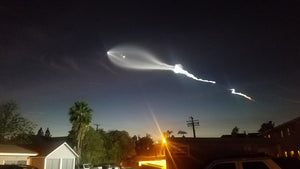May- Eta Aquarid Meteor Shower, Sombrero Galaxy and M3🌌🔭🪐🌠 + How to Timelapse!
☄️ETA AQUARID METEOR SHOWER☄️+ Timelapse Tutorial
The Eta Aquarid meteor shower is a beautiful celestial event that occurs every year in May. Creating a time-lapse video of the shower can be a great way to capture its beauty. In this article, we will provide you with a step-by-step guide on how to make a time-lapse video of the Eta Aquarid meteor shower which peaks tonight May 5th.
Step 1: Choose the Right Location
To capture the Eta Aquarid meteor shower in all its glory, you need to choose a location that is free from light pollution. Ideally, you should look for a dark sky location away from any artificial light sources, such as streetlights or buildings.
Step 2: Set Up Your Camera Equipment
You will need a DSLR camera and a tripod to capture the meteor shower. To create a time-lapse video, you will also need an intervalometer or a remote control that can trigger your camera to take a series of photos at set intervals. Once you have your equipment, set up your camera on the tripod and point it towards the radiant point of the meteor shower in the sky. The radiant point of the Eta Aquarid meteor shower is near the constellation Aquarius.
Step 3: Adjust Camera Settings
To capture the Eta Aquarid meteor shower, you need to use the right camera settings. Start by setting your camera to manual mode and set the aperture to its widest setting. This will allow more light to enter the camera and capture the stars and meteors.
Next, set the shutter speed to 15-20 seconds to capture the movement of the meteors across the sky. If you set the shutter speed to any longer than this, the stars will begin to blur due to the Earth's rotation. Lastly, set the ISO to a high value between 1600 and 3200 to capture the light from the stars and meteors.
Step 4: Start Shooting
Once you have set up your camera and adjusted the settings, it's time to start shooting. Use your intervalometer or remote control to take a series of photos at regular intervals. You should aim to take between 200-300 photos to create a time-lapse video that is around 10-15 seconds long.
Step 5: Create the Time-Lapse Video
Once you have taken all the photos, it's time to create the time-lapse video. You can use software such as Adobe Premiere Pro or iMovie to create the video. Import all the photos into the software, and then adjust the frame rate to 24 frames per second to create a smooth video. You can also add music or sound effects to the video to enhance the viewing experience.
Step 6: Share Your Creation
Once you have created your time-lapse video of the Eta Aquarid meteor shower, it's time to share it with the world. You can upload it to social media platforms such as YouTube, Instagram, or Facebook to share it with your friends and followers. You can also enter it into photography contests or share it on astronomy forums to showcase your work.
In conclusion, capturing the Eta Aquarid meteor shower in a time-lapse video can be a rewarding experience for any photography or astronomy enthusiast. By following the steps outlined in this article, you can create a stunning video that captures the beauty of this celestial event. So, grab your camera, head to a dark sky location, and start shooting!
SOMBRERO GALAXY
The Sombrero Galaxy, also known as M104, is a beautiful and distinctive galaxy located in the constellation Virgo. It is visible in the night sky with a telescope, and observing it can be a rewarding experience for any amateur astronomer. Here's how to observe the Sombrero Galaxy with a telescope:
To observe the Sombrero Galaxy, you will need a telescope with a moderate to high magnification power. A telescope with an aperture of at least 6 inches will give you the best results. You can also use a Dobsonian telescope, which is a popular type of telescope for observing galaxies and other deep-sky object.
The Sombrero Galaxy is located in the constellation Virgo, which is one of the largest constellations in the night sky. Once you have found the constellation Virgo, you need to locate the Sombrero Galaxy. It is located about 28 million light-years away from Earth and is visible as a faint, oval-shaped object in the night sky. Look for it in the southern part of the constellation, near the bright star Spica.
Look for a bright central bulge surrounded by a dark dust lane, which gives the galaxy its distinctive sombrero shape. You may also be able to see some faint outer spiral arms.
MESSIER 3
Messier 3 is a magnificent globular cluster and a true gem in the night sky. Located in the constellation Canes Venatici, Messier 3 contains hundreds of thousands of stars, all packed tightly together in a beautiful spherical shape. The cluster is estimated to be around 11.4 billion years old, making it one of the oldest objects in our galaxy. It's also one of the largest and brightest globular clusters visible from Earth, making it a perfect target for amateur astronomers.
Locate the constellation Canes Venatici in the northeastern sky, look for a faint, fuzzy patch in the northern part of the constellation. That's Messier 3! Take note of its shape, size, and brightness. Use different filters to enhance its beauty, or even take photos of the cluster with a camera attachment for your telescope.







